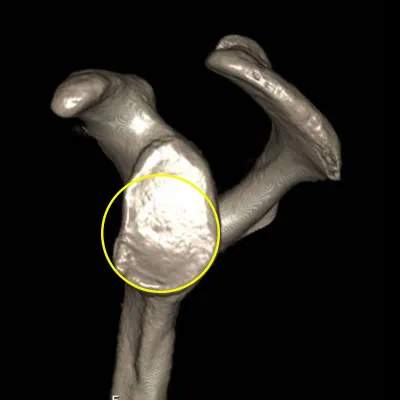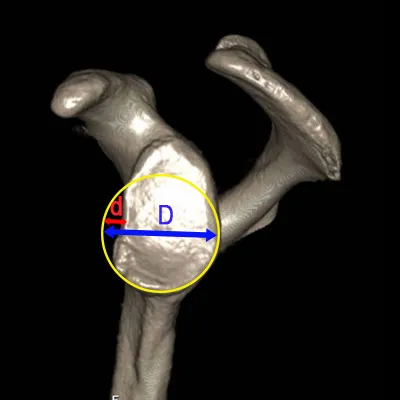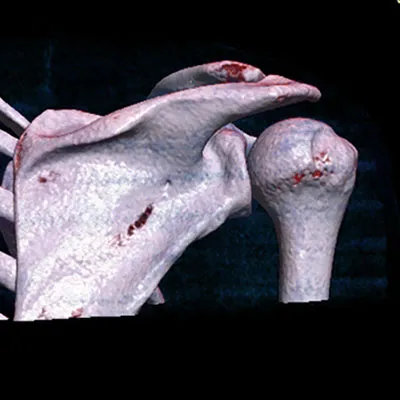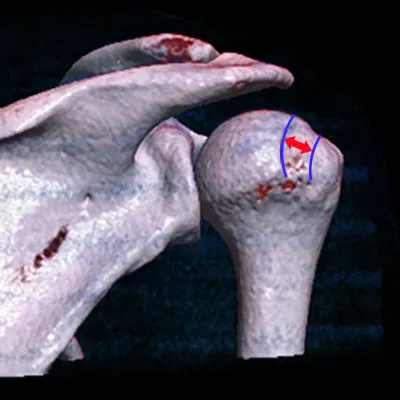Shoulder Center Saar
Glenoid Track
The Glenoid Track - Calculation and its importance for shoulder stability
The on-track and off-track concepts were developed by Yamamoto and Itoi to assess the risk of recurrent shoulder instability after anterior shoulder dislocation. This concept is based on an understanding of bone loss at the anterior glenoid socket and the bony lesion at the humeral head (Hill-Sachs lesion), as well as their interaction during shoulder movement.
What do “on-track” and “off-track” mean?
The Glenoid Track:
- The glenoid track is the area of the posterosuperior (posterior upper) humeral head surface that remains in contact with the glenoid socket during shoulder movement.
- A Hill-Sachs lesion (a humeral head indentation) is considered on-track if it lies within this glenoid track and thus does not interfere with the anterior glenoid ridge. Such lesions typically do not cause recurrent instability.
- However, if a Hill-Sachs lesion is so large or medially located that it extends beyond the glenoid track, it is referred to as an off-track lesion. This lesion can become trapped on the glenoid rim and trigger recurrent dislocations.
How do I calculate the glenoid track and perform an on-track/off-track assessment:
Calculating the width of the glenoid track:- The glenoid track (GT) is calculated using the following formula: GT = 0.83 × width of the glenoid socket.
83% of the glenoid width of the healthy glenoid is assumed, since only this part is in contact with the humeral head during movement.
To calculate the glenoid track, the maximum width of the healthy glenoid must first be determined. There are two ways to do this.
- During a CT scan, both shoulders are scanned, allowing me to visualize and measure the healthy side in addition to the affected side.
- The "Best Fit" Circle Method. This method involves drawing a circle on the scan image that perfectly matches the posterior and inferior portion of the glenoid socket. This circle is considered to be close to the original shape of the glenoid socket. See the following illustration:


Next, I measure the diameter of the circle and thus obtain the value D = maximum width of the healthy glenoid. The glenoid track (GT) is then calculated as GT = 0.83 x D
However, the glenoid track determined in this way affects the healthy side. To determine the glenoid track of the affected shoulder, I now need to measure the defect zone (d). To do this, the distance from the glenoid rim to the best-fit circle is determined at the point of maximum defect. This value in mm corresponds to d.
The glenoid track (GT) of the unstable shoulder is then calculated from the formula: GT = (0.83 x D) - d

Position of the Hill-Sachs lesion:
To assess whether a Hill-Sachs lesion is on- or off-track, the position and width of the Hill-Sachs lesion must be determined. To do this, we measure the distance from the medial (inner) edge of the Hill-Sachs lesion to the medial insertion point of the rotator cuff at the edge of the greater tuberosity. This value is referred to as the HSL (Hill-Sach lesion) and is also expressed in millimeters.


To determine the HSL, I measure the distance from the inner Hill-Sachs edge (left blue line) to the inner insertion point of the rotator cuff (right blue line). HSL corresponds to the red arrow, measured in millimeters.
As long as the measured HSL value is smaller than the calculated glenoid track of the affected side, the lesion is classified as on-track.
If the medial edge of the Hill-Sachs lesion exceeds the glenoid track and the HSL value is greater than the GT value, the lesion is classified as off-track.Clinical significance:
- On-track lesions (HSL < GT): Can often be treated with a simple arthroscopic Bankart repair.
- Off-track lesions (HSL > GT): Often require additional procedures such as Latarjet surgery (glenoid augmentation) or remplissage (filling of the Hill-Sachs lesion) to prevent recurrence of instability.
- On-track lesions (HSL < GT): Can often be treated with a simple arthroscopic Bankart repair.
- Off-track lesions (HSL > GT): Often require additional procedures such as Latarjet surgery (glenoid augmentation) or remplissage (filling of the Hill-Sachs lesion) to prevent recurrence of instability.
Our Glenoid Track Calculator:
Using the form below, you can easily calculate the glenoid track of the healthy and unstable shoulder. It also determines whether the Hill-Sachs lesion is on-track or off-track.
To do so, please enter the following measurements. Instructions for determining the measurements can be found in the above article below the figures.



